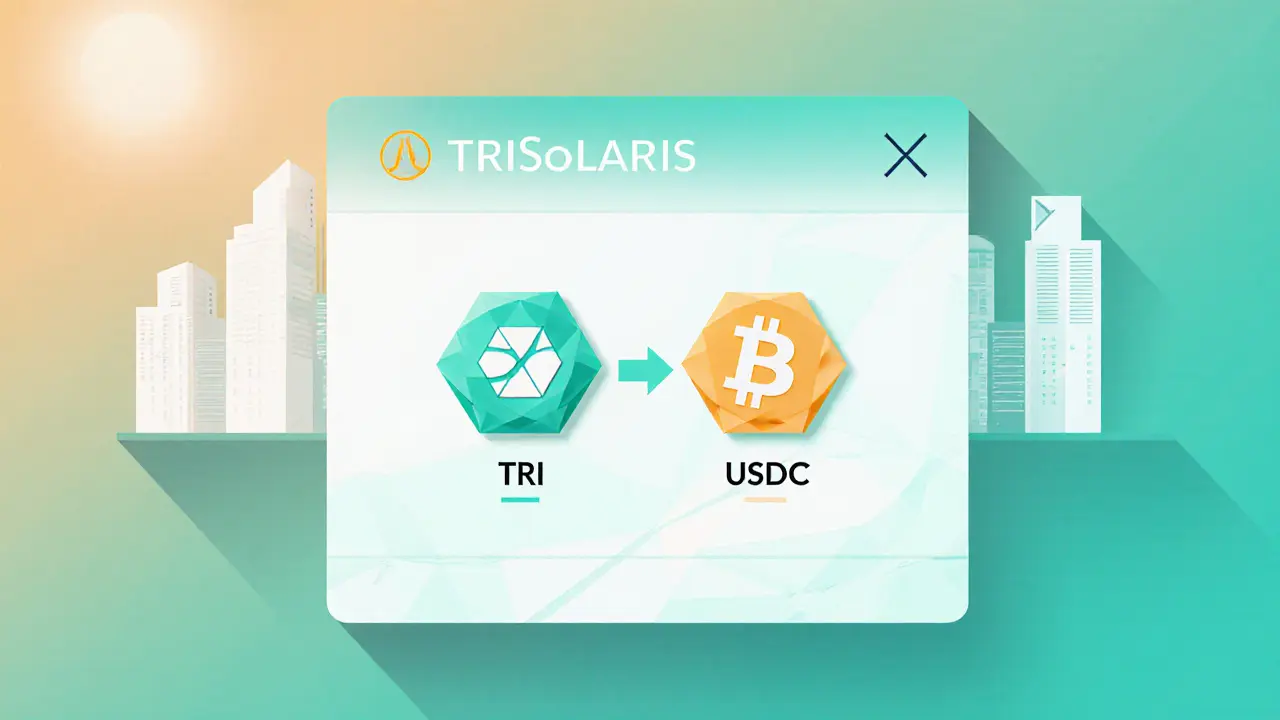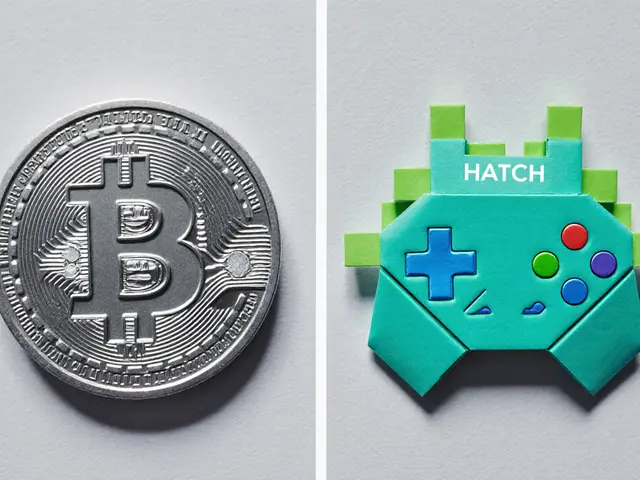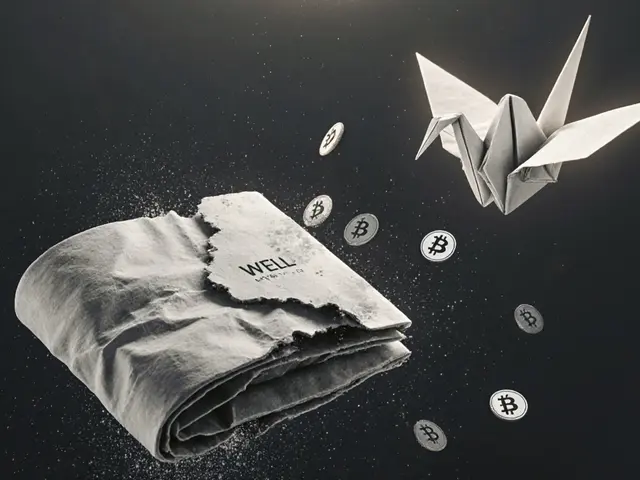Trisolaris TRI Token Liquidity Simulator
About Trisolaris
Trisolaris is a decentralized exchange built on Aurora, offering ultra-low fees and unique security features. Its native token, TRI, has a fixed supply of 181.74 million but no circulating supply as of October 2025.
This simulator helps visualize how pool liquidity affects your trades. Note that actual slippage depends on pool composition and trade size.
Simulation Results
With a $10,000 pool and a $500 trade:
- Expected slippage: 0%
- Effective price paid: $0.0001 per TRI
- TRI received: 5,000,000 TRI
- Impact on pool: 0.005%
TRI Token Details
- Total Supply: 181,742,469.62 TRI
- Circulating Supply: 0 (as of Oct 2025)
- Use Cases: Fee discounts, liquidity incentives, governance voting
- Network: Aurora (NEAR Layer-2)
When you search for a "crypto exchange" and see Trisolaris a DeFi protocol built on the Aurora network that offers near‑instant swaps with low gas fees, it’s easy to assume it works like a centralized exchange. In reality, Trisolaris is a decentralized finance platform, and its native TRI token the utility and governance token that powers the protocol. This review breaks down what the platform actually does, how you can trade it, and whether it lives up to the hype.
Quick Take
- Trisolaris review: a DeFi swap hub, not a traditional exchange.
- Runs on Aurora an Ethereum‑compatible layer‑2 on NEAR for fast, cheap transactions.
- TRI token supply: 181,742,469.62 total, 0 circulating (as of Oct2025).
- Liquidity is thin; most users access TRI via KuCoin a centralized exchange that lists TRI with custodial and non‑custodial options or directly on DEXs.
- Built‑in rug‑pull prevention smart‑contract safeguards designed to lock liquidity after a set period adds a layer of security.
What Is Trisolaris?
Trisolaris was launched in 2022 to address two pain points that plague many DeFi swaps: high gas fees and slow transaction finality. By deploying on the Aurora network, the protocol inherits near‑instant block times (≈1second) and dramatically lower fees than Ethereum’s mainnet. The platform markets itself as a “decentralized exchange” (DEX) but also bundles features like staking, liquidity mining, and a governance framework powered by the TRI token.
Tokenomics at a Glance
The TRI token serves as both a utility token for fee discounts and a governance token for voting on protocol upgrades has a fixed maximum supply of 181.74million. Strangely, there is currently no circulating supply listed on major data aggregators, which means the token is effectively locked in the team’s vesting contracts and unallocated reserves. The fully‑diluted market cap is quoted at around $112k, but the live market cap reads $0 because the token isn’t trading on high‑volume venues.
Key token attributes:
- Total supply: 181,742,469.62 TRI
- Circulating supply: 0 (as of Oct2025)
- Current price: unavailable on major price feeds
- Use cases: fee rebates, liquidity incentives, governance voting
How to Acquire TRI
Because the token isn’t listed on big CEXs like Binance or Coinbase, you’ll need to look elsewhere:
- KuCoin: The exchange offers a custodial wallet for TRI, letting you buy with fiat or other crypto pairs. KuCoin also provides a non‑custodial withdrawal option for those who prefer to hold their private keys.
- Decentralized exchanges (DEXs): Platforms such as Trisolaris DEX the native swap UI on Aurora where you can trade TRI for USDC, ETH, etc. let you purchase directly from liquidity pools. You’ll need a Web3 wallet (MetaMask, Rainbow, or similar) connected to Aurora.
- Bridge services: If you hold assets on Ethereum, a bridge like the Aurora Bridge can move them to Aurora, after which you can trade for TRI on the DEX.
For newcomers, the KuCoin route is simpler because it handles KYC and offers a familiar order‑book interface. Experienced DeFi users usually prefer the DEX route for privacy and full control.
Storing TRI Safely
Standard crypto storage best practices apply. You have two main choices:
- Custodial storage: Keep the token on KuCoin or another exchange. This is convenient for frequent trading but requires trust in the exchange’s security measures.
- Non‑custodial wallets: Transfer TRI to a hardware wallet (e.g., Ledger NanoX) or a software Web3 wallet. This follows the "not your keys, not your coins" mantra and gives you full control over private keys.
When you move TRI to a hardware wallet a physical device that stores private keys offline, protecting them from online attacks, you trade convenience for security. For most users, keeping a small balance on an exchange for quick swaps and the bulk in a hardware wallet is a balanced approach.

Security Features: Rug‑Pull Prevention
DeFi is notorious for projects that disappear with investors’ funds. Trisolaris tries to mitigate that risk with a built‑in rug‑pull prevention a time‑locked liquidity contract that only releases pool tokens after a predetermined period. The lock period is publicly visible on the blockchain explorer, allowing anyone to verify that the liquidity can’t be pulled instantly.
In addition, the protocol’s smart contracts have undergone a third‑party audit from an unnamed firm (the report is publicly available on the project’s GitHub). While no audit can guarantee zero bugs, the presence of an audit shows a minimal level of diligence.
Pros, Cons, and User Experience
Below is a quick rundown of what you’ll likely encounter when using Trisolaris.
- Pros
- Ultra‑low fees thanks to Aurora’s layer‑2 architecture.
- Integrated rug‑pull safeguards build trust.
- Fee discounts for holding TRI incentivize token adoption.
- Simple UI for swapping, staking, and liquidity mining.
- Cons
- Very low liquidity for TRI; price slippage can be severe.
- No major CEX listings limit easy fiat on‑ramps.
- Community is small; fewer educational resources compared to Uniswap.
- Tokenomics unclear because circulating supply is effectively zero.
How Trisolaris Stacks Up Against Other DeFi Swaps
| Feature | Trisolaris | Uniswap (v3) | SushiSwap |
|---|---|---|---|
| Underlying chain | Aurora (NEAR L2) | Ethereum | Ethereum + multiple L2s |
| Avg. transaction fee | ~$0.001 | ~$2‑$5 | ~$2‑$5 |
| Liquidity depth for native token | Low (thin pools) | High | High |
| Rug‑pull protection | Time‑locked pool contracts | None built‑in | None built‑in |
| Governance token | TRI | UNI | SUSHI |
| Staking / Yield farms | Yes, TRI incentives | No native staking (external) | Yes, across many pools |
Is Trisolaris Worth Your Time?
If you’re a DeFi enthusiast who values low‑fee swaps and enjoys experimenting with newer ecosystems, Trisolaris offers a niche experience on Aurora. However, the lack of liquidity for TRI means you’ll likely face high slippage if you try to move large amounts. For casual traders, sticking with a high‑liquidity DEX like Uniswap or a reputable CEX might be more practical.
Ultimately, the protocol’s success hinges on whether it can attract enough liquidity providers to make its pools deep enough for real trading volume. Keep an eye on community announcements, especially any partnership with larger L2 projects, as those could shift the balance.
Frequently Asked Questions
Is Trisolaris a centralized exchange?
No. Trisolaris operates as a decentralized finance protocol on the Aurora network. Users trade directly from their wallets without a custodial order book.
Where can I buy the TRI token?
TRI is listed on KuCoin and can be purchased on the native Trisolaris DEX via Aurora. You’ll need a Web3 wallet for the DEX route.
What is the rug‑pull prevention mechanism?
Liquidity added to Trisolaris pools is locked in a smart contract for a preset period. The lock timer is public, preventing anyone from pulling the funds before the deadline.
How do I store TRI securely?
You can keep TRI on KuCoin for easy trading, but for maximum security transfer it to a hardware wallet or a non‑custodial Web3 wallet where you control the private keys.
Is there any active community or support?
Trisolaris has a small Discord and Telegram presence. Compared to larger DEXs, the community size is modest, so updates can be slower.
Next Steps for Interested Users
1. Set up a Web3 wallet (MetaMask, Rainbow, or a Ledger) and add the Aurora network. 2. Bridge assets from Ethereum to Aurora using the official Aurora Bridge. 3. Swap for TRI on the Trisolaris DEX or buy via KuCoin if you prefer a custodial route. 4. Consider staking TRI in the protocol’s farms to earn fee rebates and governance voting power. 5. Monitor liquidity - watch the pool depth on the DEX dashboard. If it stays thin, limit your exposure.
By following these steps, you’ll get a hands‑on feel for how Trisolaris works and can decide whether its low‑fee advantage outweighs the current liquidity challenges.





Marie Salcedo
Hey everyone, just wanted to point out that Trisolaris’s low‑fee advantage really shines when you’re moving small amounts, especially on the Aurora network where gas is practically nothing. If you set up a MetaMask wallet and add the Aurora RPC, you can start swapping in minutes. The built‑in fee discount for holding TRI is a nice perk for regular traders, and the UI is straightforward enough for newcomers. For those who are nervous about smart‑contract risk, the time‑locked liquidity pools add an extra layer of safety. Overall, it’s a solid option if you value speed and cheap transactions.
Raj Dixit
Look, most of these so‑called "DeFi" platforms are just glorified playgrounds for speculators. Trisolaris pretends to be innovative while still depending on the same token‑centric model that fuels the bubble. If you actually want something built on real national infrastructure, look elsewhere. This isn’t a solution for true financial sovereignty.
Darrin Budzak
I get where Raj is coming from, but I think it’s worth noting that the low‑fee environment on Aurora does lower the barrier for casual users. Even with thin liquidity, you can still experiment without burning cash on gas. Just keep trade sizes modest and you’ll avoid big slippage.
Andrew McDonald
While the optimism is nice, let’s be realistic – the pool depth for TRI is practically nonexistent, which means any sizable move will get you wrecked. 🤨 The platform’s UI may look polished, but the underlying market depth tells a different story.
Enya Van der most
All right, team! If you’re looking to dive in, remember the power of staking your TRI for fee rebates. It’s a great way to earn while you wait for the liquidity to grow. Keep an eye on community updates – a new partnership could swing the pools dramatically!
Eugene Myazin
Totally agree, Enya. I’ve seen a few folks boost their yields by providing liquidity on the USDC‑TRI pool. Just make sure you’ve got your wallet secured, and you’ll be set to ride the low‑fee wave.
karyn brown
Honestly, the whole thing feels like a vanity project at this point 🙄. The tokenomics are a mess, and the community isn’t giving it the love it needs. If you’re not ready for a roller‑coaster, maybe skip it.
Rachel Kasdin
America leads in crypto innovation.
Nilesh Parghi
From a philosophical angle, Trisolaris illustrates the tension between decentralization ideals and practical market constraints. The platform’s transparency is commendable, yet the scarcity of liquidity reveals a deeper challenge for emerging ecosystems. It’s a microcosm of the broader DeFi narrative.
Keith Cotterill
Indeed, Nilesh, one cannot ignore the structural paradox that underpins such protocols; the ambition to democratize finance clashes with the harsh reality of capital concentration, and thus the very architecture of Trisolaris, while aesthetically pleasing, suffers from a liquidity vacuum that is, frankly, symptomatic of many Layer‑2 DEXes, thereby inviting a cautious approach for any investor seeking sustainable yields, especially when the tokenomics lack a clear circulating supply, which inevitably fuels speculation rather than genuine utility, and while the time‑locked pools aim to mitigate rug pulls, they do not address the fundamental issue of market depth, consequently, the platform remains a niche playground for the adventurous rather than a mainstream solution.
Noel Lees
Totally see your point, Keith. I’d add that the jargon‑heavy nature of the documentation can be off‑putting for newcomers, so a simplified guide would go a long way. :)
Raphael Tomasetti
From a technical standpoint, the Aurora Rollup achieves sub‑second finality, which translates to near‑instant swaps on Trisolaris. The gas cost, often measured in fractions of a cent, is a decisive factor for high‑frequency traders. However, the AMM curve’s slippage coefficient remains steep due to limited pool size, so order routing algorithms need to factor in depth before execution.
Jenny Simpson
Well, isn’t this a classic case of hype versus reality? Everyone jumps onto the Trisolaris bandwagon, singing praises about ultra‑low fees, yet they conveniently gloss over the glaring liquidity abyss that threatens to swallow any substantial trade. The platform’s promise of “instant swaps” sounds alluring, but in practice, the thin order books mean you’re paying hidden costs in the form of massive slippage. Moreover, the token’s nonexistent circulating supply raises red flags about actual market demand. It’s almost as if the developers are playing a long‑term game, banking on future adoption rather than delivering immediate utility. The rug‑pull safeguards are a nice touch, but they don’t compensate for the structural fragility inherent in a nascent ecosystem. One could argue that the whole model is a testbed for Aurora’s L2 capabilities, but until deep liquidity pools materialize, the user experience will remain sub‑par. In short, the excitement is understandable, but the fundamentals need serious work before Trisolaris can be considered a serious contender in the DeFi arena. That said, for the adventurous early‑adopter who enjoys high‑risk, high‑reward scenarios, it might still hold some allure. Still, I would advise caution and a thorough risk assessment before committing sizable funds.
Sabrina Qureshi
Wow, that's a lot to take in! Honestly, the enthusiasm is contagious, but I can't help but feel a bit overwhelmed by the sheer amount of risk involved. The lack of liquidity is a huge red flag, and the tokenomics seem almost... mysterious. Still, I appreciate the thorough breakdown. 🙃
CJ Williams
Hey folks, just a quick reminder: always double‑check the contract address before you bridge assets, and keep your recovery phrase offline. A small habit like this can save you from a lot of headaches later on! 😊
mukund gakhreja
Thanks for the tip, CJ. Honestly, most people ignore those basics until it’s too late, so your reminder is spot on. Still, the whole thing feels like a circus-too many moving parts for the average user.
Michael Ross
I appreciate all the perspectives shared here. While the platform has its quirks, I’ll keep an eye on any liquidity improvements before making a decision.